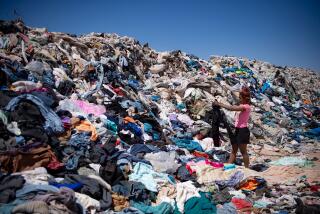Dumpster-Diving for Dollars
I was in my first year at UC Santa Barbara, living in Isla Vista, an enchanting college slum cradled by the Santa Ynez Mountains and the blue Pacific and overflowing with students. I noticed that quite a few of my neighbors had folks who were footing the bills, from tuition and books to room and board, this largess topped off with a fat wad of “play money.” As a result, they managed to waft through college with an insouciance toward life’s luxuries. And when they moved out of their apartments at the end of the school year, much got dumped. This was fine by me. One man’s trash, as they say, is another man’s treasure.
A few enterprising friends and I labeled the first week of summer “dumpster-diving season,” and when it arrived, we creatively capitalized on the discards. My short list of dumpster-dredged treasures: a fully operational, top-of-the-line microwave; Mr. Coffee makers and unopened bags and tins of French roast; an internal-frame Kelty backpack with a collapsible fishing pole stashed in a side pocket; a paper bag filled with more than 15,000 pennies; sports balls, rackets, clubs, bats and mitts; Levi Strauss denim jackets in need of nothing more than a warm-water wash; cast-iron skillets and chef knives; and, like plucking bills from a money tree, science textbooks in good condition, each of which fetched a buy-back price topping $20. I also collected abandoned beach cruisers, rebuilt them--with salvaged parts and cans of spray paint--and sold them to incoming freshmen in the fall.
On our own beach cruisers, equipped with roomy “grocery-getter” baskets, we rode the streets of Isla Vista, digging through every promising dumpster and curbside trash can, probing with our makeshift digging tools (broomsticks, hoes, bent curtain rods) to unearth our finds. We knew it was illegal; once the students had thrown their discards into the dumpster, it became the property of MarBorg Industries, Isla Vista’s trash collector. But if a dumpster proved to be a virtual breadbasket of discarded things of value, we would climb inside and root deeply in its far corners, carefully avoiding broken glass and rotting food. Rummaging of this sort typically drew long stares from students as they emerged from their apartments with armloads of perfectly usable, valuable items--toaster ovens, brass candlesticks, framed photos--they could no longer be bothered with. They often looked at us with a mix of pity and condescension, and probably thought us desperate and crazy. But to me, it was they who were the spectacle, perfect examples of America’s addiction to indifferent consumption.
In addition to bagging obvious goods, my friend S.P. ripped Marlboro Dollars and Camel Bucks from empty cigarette packs. I think he eventually cashed them in for a Windbreaker, or maybe a pool cue. He also provisioned his bathroom, laundry room and kitchen with half-full bottles of shampoo, boxes and bottles of detergent, unused Brillo pads, dishwashing soap, bath mats, dish towels, cutting boards and anything else to complement the converted garage he called home. Another friend, Rudy, lifted unopened 10-pound bags of jasmine rice and Costco-sized containers of Ortega chili beans and peanut butter--chunky if he was lucky--from the refuse. Each summer he fed himself safely and somewhat healthfully on salvaged foodstuffs, perfectly edible post-consumer waste.
Discovering the internal-frame backpack was quite the score, of course, and I kept it--the winter after graduation I stuffed it with essentials and shouldered it across Costa Rica for two months. But I was really dumpster diving for the monetary payoff. Indeed, we kept hardly anything for ourselves. Rather, we scavenged until the pile outside S.P.’s garage became a bit unwieldy, then we tossed it all into the back of his ’59 Chevy Apache, hauled it to the swap meet at the crack of dawn on a Sunday and sold it all. We haggled good prices for high-end items (spotless microwaves, upright Hoover vacuums, CD boomboxes, 50-foot garden hoses) and parted with low-end junk (Steve Miller cassette tapes, Christmas ornaments, three-ring notebooks, beat-up pots and pans) for a quarter or 50 cents a pop. Typically, before noon, each of us had pocketed more than $100. With our pockets stuffed with wads of fives and ones and bulging with quarters, dimes and nickels, we traditionally drove straight to Lupita’s restaurant in Isla Vista and purchased several ice-cold pitchers of Mexican beer and broad plates of chicken enchiladas. Sometimes, though we knew it was a rather inconsiderate move, we paid the entire lunch tab with loose change.
I scavenged to stay out of debt, to keep my wallet above the poverty line as I burned through the early ‘90s sitting through class and studying during the day and stealing from my sleep five or six nights a week to flip fish at a seafood restaurant. Being a “poor, starving student,” I soon discovered, came at a hefty price. Fortunately, my fish-grilling gig cut me a steady paycheck, one meal per shift, and some tips. But it was scarcely enough to break even. Out of financial necessity, I maintained a low overhead. I rarely ate out. I opted for incredibly cheap but hardly protective car insurance. I drove less. When I needed new clothes, I bought old clothes from thrift stores, swap meets and yard sales. And I scavenged.
Plus, scavenging was kind of fascinating, in a grubby sort of way. Not something to write home about (although I did once, instilling in my mother the fear that her youngest son would accidentally step on a discarded hypodermic needle and wind up dying from a dumpster-diving mishap.) Surprisingly, I learned quite a bit about myself and the world I’m from during those early Saturday and Sunday mornings, as the tattered summer fog hung in the streets and the community slept off the hangovers of a week’s worth of year-end partying. And I made a few new friends, some of whom were strapped students like myself, others who were the hard-working husbands and fathers of struggling families who had recently arrived in the United States.
Another thing that kept me preoccupied with the waste stream was my budding, burning idealism. (You know what college can do to a young mind.) I was a student of the nation’s oldest environmental studies program. And although I spent most of my time avoiding the 18-year-old born-again-hippie environmentalists--you know, the ones who bemoan animal cruelty and meat-eating but bedeck themselves in leather--I did learn a thing or two about humankind’s habits of consumption and disposal. Basically, we buy too much stuff that we think we need but don’t, then when we no longer need said stuff--and fail to find an incentive to recycle it all--we dump most of it into a huge, growing hole in the ground somewhere out of sight and out of mind. I didn’t want to be a part of that problem. Scavenging was my way to subvert the system.
These days, a decade later, I can no longer count myself among the ranks of the true scavengers, but I rarely walk past a dumpster without giving what’s inside at least a quick scan. I am still driven, however--by financial necessity, by the intrigue of the hunt, by the style and quality of things made long ago--to discover the practical (or just plain cool) treasures buried at most swap meets, yard sales and thrift stores. And I remain slightly dismayed and amused by the consumption that still fills all those Isla Vista dumpsters.
More to Read
Sign up for Essential California
The most important California stories and recommendations in your inbox every morning.
You may occasionally receive promotional content from the Los Angeles Times.










